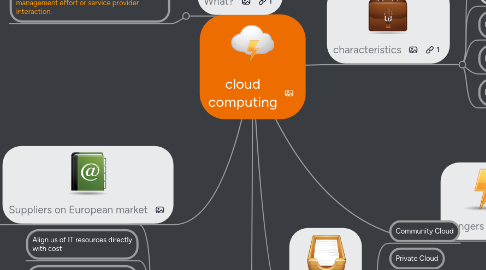cloud computing
by Eline Goossens


1. reasons
1.1. Scale up IT capacity on-demand
1.2. Align us of IT resources directly with cost
1.3. Provide more IT agility to adapt to new business opportunities.
1.4. Mix and match the right solutions for the business without having to purchase hardware and software.
1.5. Place business volatility into a single domain...the cloud.
1.6. Reduce operational costs, while increasing IT effectiveness.
1.7. Manage huge data sets.
1.8. Create customer-facing systems quickly
1.9. Shift capital dollars to other places needed by the business.
1.10. Balance processing between on-premise and cloud systems
2. Suppliers on European market
2.1. Suppliers?
2.1.1. Terremark
2.1.2. Combell
2.1.3. Rackspace
2.1.4. Softplayer
2.1.5. Windows
2.2. Who?
2.2.1. An IT system administrator who does not build clouds but deploys onto them, probably in addition to traditional managed systems.
2.2.2. A developer who employs dynamic resource allocation in clouds to speed application or solution creation.
2.2.3. A service provider who needs to handle peak load demands.
2.2.4. A “cloud choreographer” who strings together cloud-based services to implement business processes.
2.2.5. A non-technical end user who accesses services through a browser or via applications such as disk backup to remote storage.
2.2.6. A user of a virtualized desktop on a thin or fat client.
